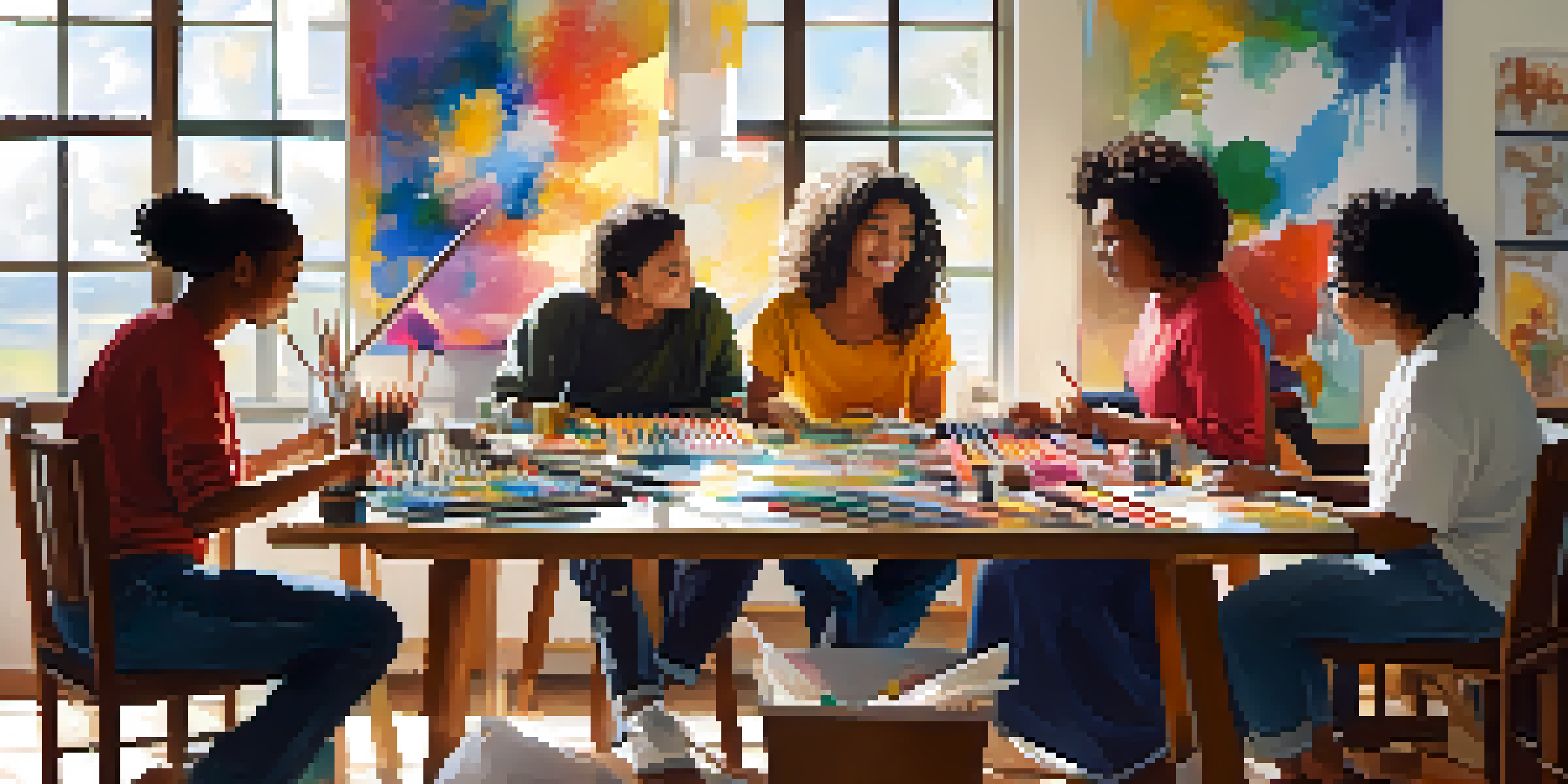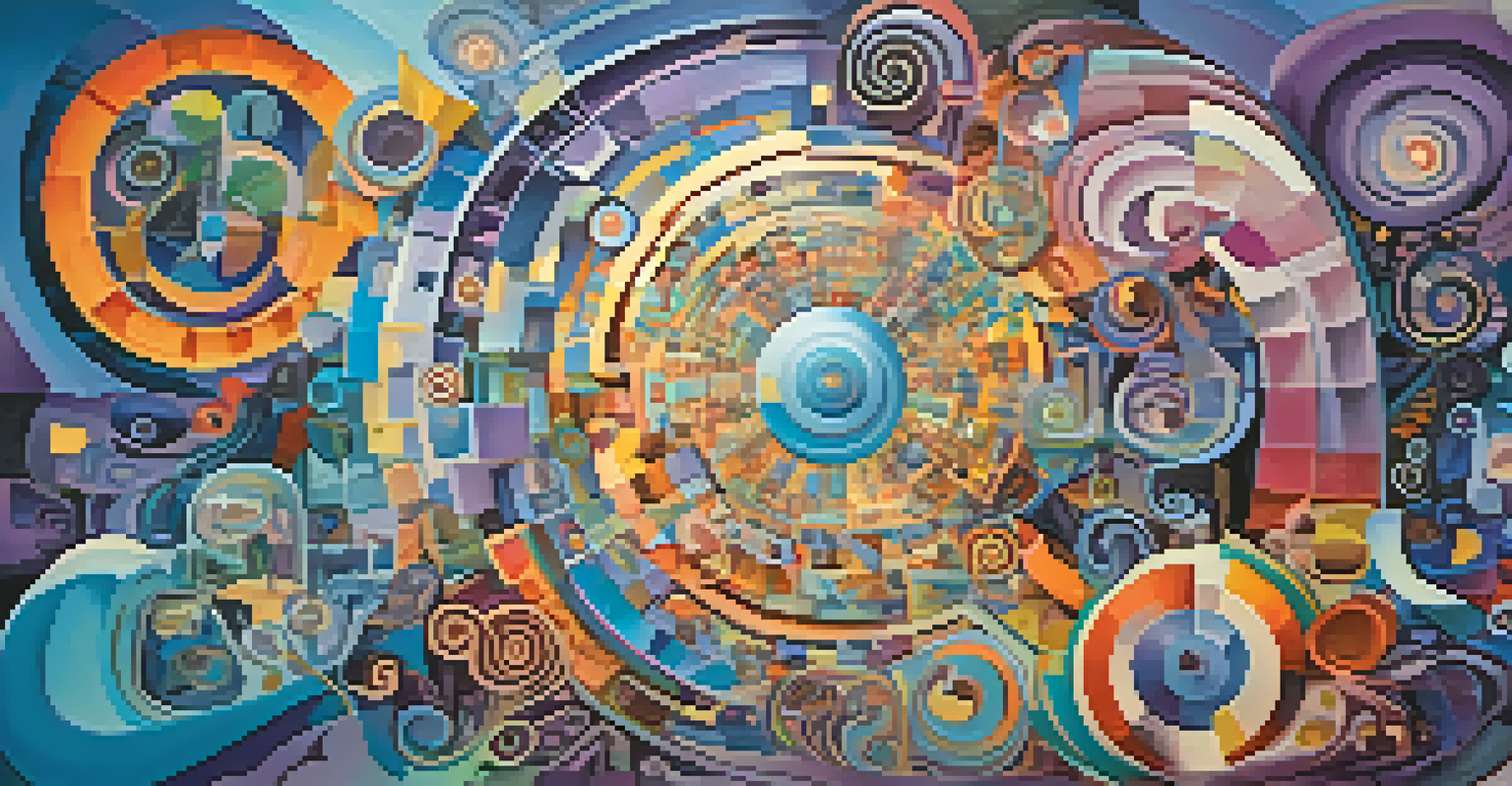Art Therapy: Healing Through the Subconscious and Creativity

Understanding Art Therapy and Its Benefits
Art therapy is a unique therapeutic approach that combines art and psychology to promote healing and self-discovery. It allows individuals to express their feelings through creative mediums, such as painting, drawing, or sculpting. By engaging in artistic activities, people often find it easier to communicate emotions that are difficult to verbalize.
Art is not freedom from discipline, but disciplined freedom.
This form of therapy is beneficial for individuals of all ages and backgrounds, as it fosters personal insight and emotional resilience. It can be particularly helpful for those dealing with trauma, anxiety, or depression, offering a safe space to explore complex feelings. Additionally, art therapy encourages mindfulness, allowing individuals to remain present and engaged in the moment.
Through the creative process, participants can uncover hidden thoughts and emotions stored in their subconscious. This journey of self-exploration not only aids in emotional healing but also enhances overall mental well-being. In essence, art therapy serves as a powerful tool for personal growth and transformation.
The Role of the Subconscious in Creativity
The subconscious mind plays a pivotal role in creativity and self-expression. It houses our deepest thoughts, fears, and desires, often influencing our behavior and emotional responses. When engaging in art therapy, individuals tap into this reservoir of subconscious material, allowing them to process and understand feelings that may be difficult to articulate.

For example, a person might paint a chaotic scene to represent their inner turmoil, revealing emotions they were previously unaware of. This process can be cathartic, as it provides an opportunity to confront and express feelings that have been suppressed. By accessing the subconscious, art therapy helps individuals gain insight into their emotional struggles and fosters a sense of empowerment.
Art Therapy Promotes Healing
Art therapy combines creative expression with psychological support, helping individuals process emotions and foster personal growth.
Moreover, the creative act itself can stimulate the subconscious, sparking new ideas and perspectives. As individuals immerse themselves in the artistic process, they may experience spontaneous insights or breakthroughs, leading to a deeper understanding of themselves. This dynamic interplay between creativity and the subconscious is at the heart of art therapy's healing potential.
Different Forms of Art Therapy
Art therapy encompasses a variety of creative expressions, each with its unique benefits. Some common forms include drawing, painting, sculpture, and even digital art. These diverse mediums allow individuals to choose the method that resonates most with them, making the therapeutic process more personal and effective.
Every artist dips his brush in his own soul, and paints his own nature into his pictures.
For instance, drawing might be an ideal choice for someone who prefers a more direct, hands-on approach, while painting can offer a broader canvas for emotional exploration. Sculpture allows for a tactile experience, engaging the senses in a way that can be profoundly grounding. By experimenting with different forms, individuals can discover which medium best facilitates their emotional expression.
Additionally, art therapy can incorporate elements like music, dance, and drama, expanding the possibilities for creative exploration. This versatility means that art therapy can be tailored to meet the unique needs of each participant, making it accessible and relevant. Ultimately, the goal is to find an expressive outlet that resonates and fosters healing.
The Therapeutic Process of Art Therapy
The therapeutic process in art therapy typically involves a trained art therapist guiding individuals through creative exercises. Sessions may begin with a discussion about feelings or experiences, allowing participants to identify areas they wish to explore. This initial conversation helps establish a safe environment where individuals feel comfortable expressing themselves.
Once goals are set, participants engage in creative activities that align with their therapeutic aims. The therapist provides support and encouragement, facilitating dialogue about the artwork created. This reflective process helps individuals gain insights into their emotions and experiences, promoting healing and self-awareness.
Subconscious Influences Creativity
Engaging in art therapy allows individuals to tap into their subconscious, revealing hidden emotions and facilitating self-discovery.
It's essential to note that there is no right or wrong way to create art in therapy. The focus is on the process rather than the final product. This emphasis on exploration and expression allows individuals to reconnect with their authentic selves, fostering a sense of freedom and release.
Art Therapy for Trauma Recovery
Art therapy has shown remarkable effectiveness in aiding trauma recovery. For individuals who have experienced traumatic events, traditional talk therapy may not suffice, as they might struggle to articulate their feelings. Art therapy provides an alternative means of expression, allowing individuals to process trauma in a safe and creative way.
Through artistic expression, trauma survivors can depict their experiences visually, which can be less threatening than verbalizing them. This creative outlet can facilitate the release of pent-up emotions and help individuals confront their pain. By externalizing their feelings through art, they can begin to make sense of their experiences and work toward healing.
Moreover, art therapy fosters a sense of empowerment by enabling individuals to regain control over their narrative. As they create and reflect on their artwork, they can reclaim their identity beyond the trauma. This transformational journey is a vital aspect of the healing process, allowing individuals to move forward with renewed strength and resilience.
The Science Behind Art Therapy
Research has increasingly supported the efficacy of art therapy in promoting mental health and emotional well-being. Studies have shown that engaging in creative activities can lead to a decrease in anxiety and depression symptoms. When individuals express themselves artistically, they often report feeling a sense of relief and emotional release.
Neuroscientific studies suggest that creative expression activates different areas of the brain, particularly those related to emotions and memory. This brain activity can enhance emotional regulation and help individuals process complex feelings. As a result, art therapy not only offers a means of expression but also contributes to positive neurological changes.
Effective for Trauma Recovery
Art therapy offers a safe outlet for trauma survivors to express their experiences, promoting healing and empowerment through creativity.
Furthermore, art therapy has been integrated into various clinical settings, including hospitals, schools, and rehabilitation centers. Its adaptability and effectiveness make it a valuable resource for mental health professionals. As awareness of its benefits continues to grow, art therapy is becoming an essential component of holistic healing practices.
Getting Started with Art Therapy
If you're interested in exploring art therapy, the first step is to find a qualified art therapist who can guide you through the process. Many therapists offer introductory sessions to help you understand what to expect and how art therapy can benefit you. It's crucial to find someone you feel comfortable with, as the therapeutic relationship plays a significant role in the healing process.
Once you start, be open to the creative process and allow yourself to explore without judgment. Remember, there’s no need for artistic talent; the focus is on expressing your feelings rather than creating a masterpiece. Embrace the freedom that comes with creating, and let your emotions guide your artistic choices.

Lastly, consider incorporating art into your daily life, even outside of therapy sessions. Engaging in creative activities like journaling, doodling, or crafting can enhance self-awareness and emotional well-being. By making art a regular part of your routine, you can continue to tap into the healing power of creativity long after your therapy sessions have ended.